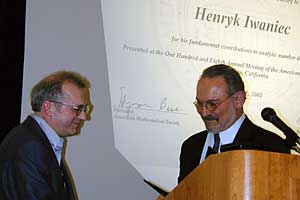
Highlights of the Joint Mathematics Meetings in San Diego, California, January 6-9, 2002
There were over 4,800 registrants at the Joint Mathematics Meetings in San Diego--nearly 3,900 mathematicians, the rest exhibitors, press and guests. Among the events at the meetings were scientific sessions, invited talks, minicourses, panels, poster sessions, a Reception for First-Time Participants sponsored by Powell's Technical Books, and the Prize Ceremony Reception sponsored by McGraw-Hill Higher Education. In addition, there were exhibits, the Employment Center, an Email Lab sponsored by Wolfram Research, a student hospitality center, the press room, and a networking center. Design Science, Inc. sponsored the registration bags for all attendees. There were plenty of opportunities and places for attendees to relax and socialize informally.
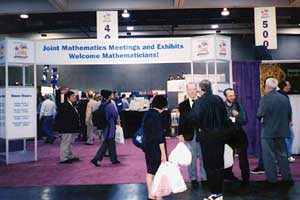
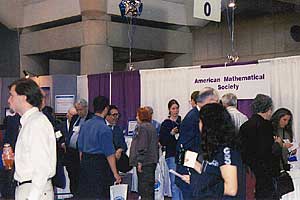
Here are some of the highlights. Those who attended the meetings can recall some of these events, and those who were not able to attend can sense the variety of experiences that the annual meetings offer. We invite you to come to next year's Joint Mathematics Meetings in Baltimore, Maryland, January 15-18!
Mathematics at the National Security Agency* The Employment Center* The Exhibits* A Conversation with the NCTM President* Reflections on the future of mathematics* Who Wants To Be A Mathematician* Vindicating Leibniz in the Calculus Priority Dispute* How the World Sees Mathematicians* The Mathematics Community and Public Support* Cinemath: Mathematics on the Silver Screen* Mathematics in a Postmodern Age* Joint Prize Session* The Earliest Chinese Mathematical Text* Teaching Evaluations-Friend or Foe?* Banking on The Weakest Link* Harmonic Numbers and the ABC-conjecture* Time Out for Socializing and Connecting with Colleagues* What do HIV and Differential Equations Have in Common?* Joint Mathematics Meetings Publicity and the Press Room* AMS Banquet
Mathematics at the National Security Agency
James R. Schatz, National Security Agency
AMS Committee on Science Policy-MAA Science Policy Committee Government Speaker
On Tuesday afternoon Dr. James Schatz, Chief of the Mathematics Research Group at the National Security Agency (NSA), gave this invited address. Dr. Schatz described the recent history of the agency and what it is like to work there. He also took time to thank the U.S. mathematics community for much of the success of the NSA. After hitting a low point in the mid-1980s, NSA officials sought advice from chairs of the country's top 50 mathematics departments on how better to fulfill its main mission of making and breaking codes. The advice given by the chairs led to programs to employ more and better mathematicians at the agency.
Work at the agency is team-oriented. Dr. Schatz pointed out that, "with the adversaries we're up against, it's not about what an individual can do, it's about what we as a team can do." He described the problems that NSA mathematicians work on as "absolutely immediate," and added, "We don't have the luxury of changing the problem or adding hypotheses." When government officials have seen the results of NSA's work, they have often commented, "It's a miracle what you've done." NSA's Barbara McNamara's response was, "It's not a miracle, it's the mathematics." Dr. Schatz concluded by expressing appreciation to mathematicians: "Over the last ten years, we have built this powerful mathematics force. Any of you who have taught have helped in an immense way, and hundreds have helped directly by solving our problems."
--- Mike Breen, AMS Public Awareness Officer
The Employment Center
Co-sponsored by the MAA and SIAM; organized, managed and staffed by AMS personnel.
The 2002 Employment Center was quite popular with employers (159 tables) and applicants (370) again this year. The job market is still favorable for applicants, and many found themselves juggling 20 or more interviews over the three and one-half days. This year's employer/applicant ratio, while good, is slightly less favorable than last year's, which probably signals the beginning of a downturn in the market.
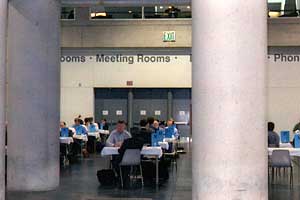

One hundred forty booths representing 76 organizations, companies, agencies and others displayed, demonstrated and/or sold a variety of publications, goods and services--books, journals, videos, CDs, software, hardware, internet products and services, and gifts--for mathematicians. The area was bustling with activity and served as a central point where colleagues shopped, networked, and renewed friendships.
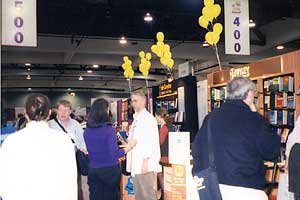
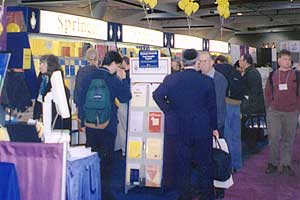

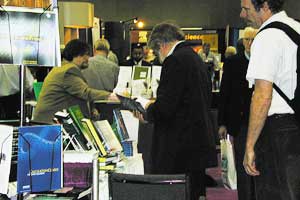
The professional mathematical societies had representatives available at their booths, well-known authors from various publishers were available to sign their books, and many exhibitors offered drawing with exciting door prizes.
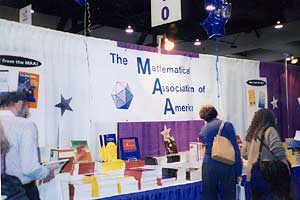
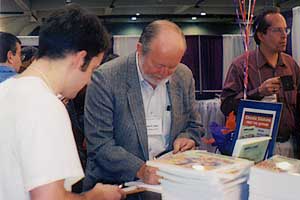
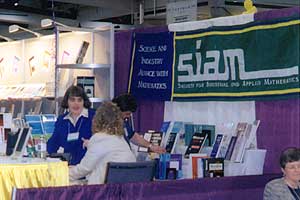
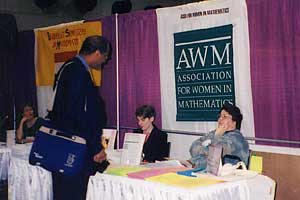
--- Penny Pina, Exhibits Coordinator
A Conversation with the NCTM President: Facing the Challenges of U.S. Mathematics Education Together
The National Council of Teachers of Mathematics (NCTM) is the main professional organization for math teachers in the United States, with about 100,000 members. The AMS Committee on Education invited the president of NCTM, Professor Lee V. Stiff, to speak at the Joint Mathematics Meetings. Rather than presenting a prepared speech, Stiff, who is on the mathematics and mathematics education faculties at North Carolina State University, first made a few remarks and then opened up the floor to a conversation with the audience. In his remarks, Stiff noted that the United States has gone through several cycles of mathematics education reform. The aim of the cycle of reform that came in the 1950s and 1960s was to produce an elite corps of students with a high level of mathematical training. Today, Stiff noted, the impact of mathematics, science, and technology on all aspects of modern life means that the nation must now aim to have all students performing at high levels in mathematics. And it's not just a matter of "back to basics. Stiff presented some data from a study in which a large majority of U.S. 4th graders did just fine adding and subtracting three-digit numbers using pencil and paper. But when those same calculations surfaced in a word problem, only one-third of the students got the right answer. His remarks were followed by a lively discussion period that lasted about an hour. Much of the conversation with Stiff focused on the need to improve the background of math teachers, especially at the middle school level. Stiff noted that when teachers return to colleges or universities to improve their mathematical backgrounds, it's not enough to put the teachers into abstract mathematics courses intended for those going on to become mathematicians. Mathematics departments should provide courses tailored to the teachers' needs, emphasizing in-depth understanding of the material they will teach. There was also considerable discussion of the time pressures on U.S. teachers: They spend so much time in the classroom that they don't have enough time in the workday for reflection on and improvement of their mathematical understanding and teaching methods.
--- Allyn Jackson, Deputy Editor of the Notices of the AMS
Reflections on the Future of Mathematics
Felix E. Browder, Retiring AMS Presidential Address
Felix Browder of Rutgers University, who served as president of the AMS during 1999-2000, presented his Retiring Presidential Address during the Joint Mathematics Meetings in San Diego. His address, entitled "Reflections on the Future of Mathematics," began with a discussion of one of the most famous lectures concerning the future of mathematics: David Hilbert's speech at the 1900 International Congress of Mathematicians, in which he presented his legendary list of what he considered the most important problems in mathematics. The fame of the Hilbert Problems notwithstanding, there are a few ironies, Browder pointed out, such as the fact that Hilbert never worked on the problems himself. Furthermore, the hopes for developments in logic and foundations encapsulated in the Hilbert Problems were completely dashed by the work of Kurt Goedel and others. Nevertheless, Browder said that efforts like Hilbert's benefit mathematics by stimulating research. Moving to the present day, Browder discussed what he believes are likely to be active areas of research in mathematics in the future. He suggested that the term "bisociation," coined by the political and scientific writer Arthur Koestler, provides a good description of many of these areas. Bisociation comes about when two seemingly unrelated things are revealed to have fundamental connections. Browder pointed to examples of bisociation in which mathematics and other disciplines---such as computer science, molecular biology, or nanotechnology---are shown to have important links. He also presented some examples of bisociation within mathematics, such as the Atiyah-Singer Index theorem, in which K-theory and differential geometry on the one hand, and elliptic partial differential equations on the other hand, were identified in a fundamental way. Browder believes that such connections will be the hallmark of much of the internal development of mathematics in the future. He also discussed how mathematics interacts with the institutions of society, such as higher education, the government, and private foundations.
--- Allyn Jackson, Deputy Editor of the Notices of the AMS
Who Wants To Be A Mathematician
Hosted by Mike Breen, AMS Public Awareness Officer
Who would have thought that you'd see audience members do "the wave," hold up banners, and cheer raucously at a math game--but that and more goodwill happened at the Who Wants To Be A Mathematician game, now a tradition at the annual Joint Math Meetings. Developed by Mike Breen and Bill Butterworth (Barat College of DePaul University), this game of pre-calculus questions with multiple choice answers attracted a standing-room only audience of mathematicians at the meetings and high school students who came to support their competing classmates from ten local high schools.

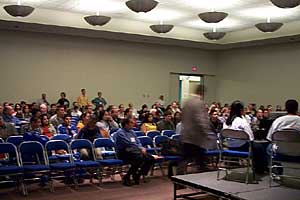

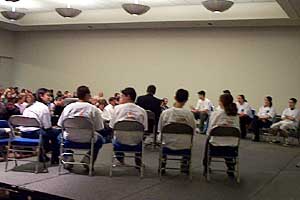
Neil Chua of Chula Vista High School handily won the $2,000 grand prize donated by the AMS. He was interviewed by local ABC affiliate channel 10 after the game and appeared on that station's evening news--telling of his interest in math, the support of his parents, and his involvement in many other activities at school. The game was also covered on the CBS affiliate station's Channel 8 Evening News.
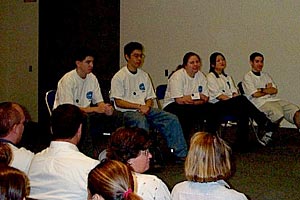

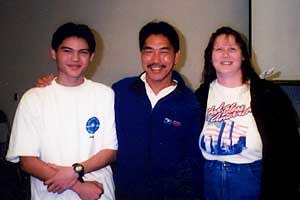



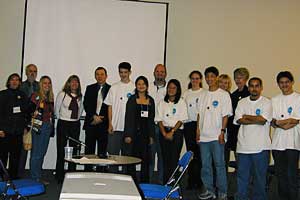
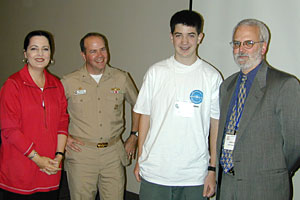
--- Annette Emerson, AMS Public Awareness Officer
Vindicating Leibniz in the Calculus Priority Dispute: The role of Augustus De Morgan
Adrian Rice, Randolph-Macon College, at the AMS-MAA Special Session on History of Mathematics
Although Isaac Newton waited 40 years to make public his development of calculus in the late 1660s, few have ever disputed that he was the first to invent it. Gottfried Wilhelm von Leibniz developed calculus independently in 1673, and was the first to publish an account of it, in 1674. But in 1704 Newton effectively charged Leibniz with plagiarism, claiming that Leibniz's calculus emerged only after a careful study of Newton's notes. A bitter dispute ensued, capped by Leibniz's request that the Royal Society of England formally exonerate him from the plagiarism charge. The Society refused, and its report contained strong hints that Leibniz had indeed stolen Newton's ideas. This finding is hardly surprising, as Newton himself held the presidency of the Society and Leibniz was not even called to testify during the deliberations.
For the rest of the 18th century in England, Newton's star shone ever brighter. The Church of England at the time held that religious, moral, and scientific virtue were indissociable. In the face of Newton as the nation's preeminent scientific genius, he was esteemed to have been the national paragon of moral and religious virtue as well. Thus any questioning of his character became an attack on the character and religion of England.
It was not until the middle of the 19th century that the Newton myth began to crack. The first British author to attempt to prove Leibniz's innocence, and thereby cast doubt on Newton's character, was Augustus De Morgan, who today is best remembered for the set theory laws that bear his name. A committed secularist and noted nonconformist, De Morgan had an intellectual independence that allowed him to pursue the dispute for its own sake, and not as part of a broad philosophical and religious perspective. Despite the hostile environment, his work received some attention in England. It began the slow rehabilitation of Leibniz in that country, and helped revive the idea that the intellect is distinct from morals.
--- Rafe Jones, AAAS-AMS Media Fellow, 2001
How the World Sees Mathematicians
A panel sponsored by the AMS Committee on the Profession; organized by Allyn Jackson, Deputy Editor of The Notices of the AMS; moderated by Keith Devlin
Instigated by the increase in the number and popularity of such works as A Beautiful Mind (the recently released film based on the biography of John Nash written by Sylvia Nasar), David Auburn's Pulitzer-prize winning Broadway play Proof, and books by Simon Singh and others, the AMS thought it would be interesting to examine how and why mathematicians are portrayed in these works and in the media. Keith Devlin (Stanford University, author and regular math commentator on NPR) introduced the discussion by showing clips from A Beautiful Mind, Goodwill Hunting, It's My Turn and Pi, and by projecting results of a survey conducted in five countries on how 12-and 13-year olds perceive mathematicians. Panelist Brian Hayes (writer for American Scientist) revealed that for a number of reasons he does not choose to see most films that portray mathematicians. Panelist David Bayer (Columbia University, and mathematics consultant--and Russell Crowe's hand double--for A Beautiful Mind) relayed some stories about how he was able to contribute ideas on the mathematician's thought process and the academic life portrayed in the film. Devlin posed some provocative questions to which the panelists responded and the audience reacted afterwards. During the "Q & A" period audience members both expressed opinions and asked questions about how the world sees--or should see--mathematicians.
In the end, there was a lot of food for thought: Are perceptions of mathematicians better in countries where the media air children's programming that includes mathematics? Are mathematicians competitive? Are mathematicians smarter than other people? Or more prone to mental illness? How do writers, playwrights and filmmakers choose to portray mathematicians? How can--or should--the mathematics profession change or improve perceptions about mathematicians and mathematics?


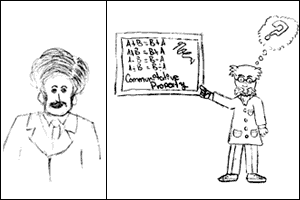
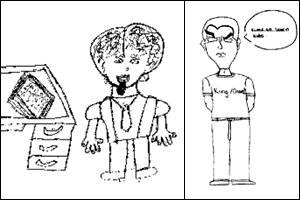
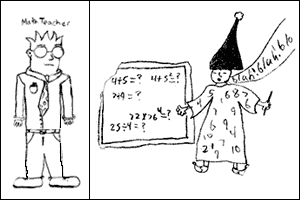
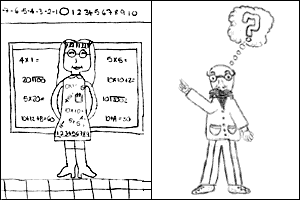
The Mathematics Community and Public Support
MAA Panel Discussion, Moderator: Mike Breen, AMS Public Awareness Officer
Panelists: Deanna Caveny, College of Charleston; Daniel L. Goroff, Harvard University; Joseph Malkevitch, York College, City University of New York; Daniel N. Rockmore, Dartmouth College
The guiding principle of the discussion was voiced by Prof. Malkevitch: "We have to believe that math requires public support." On a pragmatic level, government and public funding would dry up if the public felt math was truly useless. More profoundly, the next generation will be lacking in mathematicians if parents and kids today don't think well of math.
Given this, the speakers addressed the question of how to increase public support of math. Prof. Caveny spoke of a high school math contest she’d organized, and emphasized the cultivation of good relationships with both local and state government officials. Prof. Rockmore has contributed articles on mathematical topics to many national publications. He also showed the trailer for an hour-long video on mathematics, The Way of Math, that showcased the human side of the discipline and its practitioners. Prof. Goroff drew on his experience in Washington to give tips for relating to government officials.
Though part of the discussion was abstract, concrete ideas abounded. Prof. Goroff advised always taking students or young people when going to speak to a government official. Prof. Malkevitch urged teachers to point out that math is behind lots of electronics, like video games, CDs, and CAT scans. Prof. Rockmore noted that publications are desperate for material that enlightens the public in some way about what mathematicians do. He recommended writing up short pieces and sending them to newspapers. He'd done just that with a piece arguing that Goodwill Hunting wasn't really a math movie, and an editor at the New York Times liked it and put it in the paper.
--- Rafe Jones, AAAS-AMS Media Fellow, 2001
Cinemath: Mathematics on the Silver Screen
Charlie L. Smith, Park University, at the MAA Session on History of Mathematics in the Second Millennium
More film clips than talk, this presentation had the audience hooked from the beginning. The first clip was from The Wizard of Oz, and showed Oz awarding the Scarecrow his ThD (Doctor of Thinkology). Upon receiving it, the Scarecrow declares as evidence of his enlightenment, "the sum of the square roots of any two angles of an isosceles triangle is equal to the square root of the third angle." At this point, Prof. Smith stopped the tape and took a close look at what he called the Scarecrow's conjecture. He showed that not only did it not hold for isosceles triangles, but in fact holds for no triangles at all. The next clip came from the movie Little Man Tate, and showed two young prodigies answering complicated sounding number-theoretic questions. These were for the most part correct, and Prof. Smith showed how one problem led to a generalization that had escaped his ability to prove. At this point his time was up, but he promised more clips and quips next year.
--- Rafe Jones, AAAS-AMS Media Fellow, 2001
Mathematics in a Postmodern Age
Moderator: Russell W. Howell, Westmont College
Panelists: W. James Brady, Calvin College, and Calvin Jongsma, Dordt College
To illustrate one of postmodernism's main ideas, one panelist told a story. Three umpires are in a bar, discussing their profession. The first says, "There are balls and there are strikes, and I call 'em as they are." The second chimes in, "There are balls and there are strikes, and I call 'em as I see 'em." The third then declares, "There are balls and there are strikes, but they ain't anything until I call 'em."
Among the umpires, the third is the postmodernist. Founded as a critique of the modernist point of view, in which rational thought would eventually allow humans complete understanding and control of the physical world, postmodernism has gained considerable influence in recent decades. Though generally known as a literary and political movement, its influence has consequences for math.
One panelist listed advantages and disadvantages of both modernism and postmodernism in math education. The principal advantage of modernism was the increased importance it placed on the study of math in the K-12 curriculum. Its main disadvantages were a narrow focus on the abstract, and not enough attention to individual learners. Postmodernism, on the other hand, has encouraged active engagement on the part of the learner and reemphasized the connections of math to other disciplines and the everyday world. However, it's also produced a hesitancy to correct flawed student work and has put undue focus on the process at the expense of the product.
Another panelist discussed the effects of pop-culture postmodernism, in which the experiential reigns supreme and the cognitive is disparaged. This ethos, he claimed, can lead people to dismiss math as irrelevant. To combat this perception, he proposed working towards an increased public awareness of obvious applications of mathematical ideas, like the fact that many city streets are laid out on a grid. He also contended Math Awareness Month was a step in the right direction.
--- Rafe Jones, AAAS-AMS Media Fellow, 2001
Read the January 2002 Prizes and Awards booklet, which lists the prizes, citations, prizewinners and their biographies and responses.
The Earliest Chinese Mathematical Text: The Book of Arithmetic
Joseph W. Dauben, Lehman College, CUNY, at the AMS-MAA Special Session on History of Mathematics
For a long time, "The Nine Chapters of Arithmetic" was the oldest extant Chinese text devoted exclusively to mathematics (it survives in an edition with commentary completed by Liu Hui in 263 A.D.). But in the early 1980s, another text was discovered in excavations of a tomb dating to ca. 186 B.C. of an official in the service of the Chinese dowager empress Lu Hou. This earlier text, entitled "The Book of Arithmetic," was the subject of a talk at the Joint Mathematics Meetings by Joseph Dauben, Professor of History and History of Science at Lehman College, City University of New York, and a member of the Ph.D. Program in History at The Graduate Center of CUNY. One major challenge "The Book of Arithmetic" poses to historians is its physical presentation: The text was written on narrow strips of bamboo, which were originally tied together with string, Venetian-blind fashion, and the strings have completely deteriorated. Dauben said that putting the bamboo strips in the right order will require considerable work. "The Book of Arithmetic" discusses arithmetic operations, how they can be used in practical problems, and methods of solution. For example, one section of the book, called "Taking Away Money" or "Taking Away Gold", discusses subtraction, including subtraction of fractions. The book talks about how arithmetic can be used in taxation, commerce, measurement of geographical areas, and calculation of volumes. The number pi---which has an infinitely long, nonrepeating decimal expansion---is used in "The Book of Arithmetic," and its value is taken to be 3. The need for more accurate approximations to pi is discussed by Liu Hui in his commentary on The Nine Chapters," which in a number of respects bears remarkable similarity to "The Book of Arithmetic" and seems to have been based on, or to a large extent derived from, the earlier text. Dauben said that "The Book of Arithmetic" reflects the importance Chinese philosophy gives to classification as a way of organizing and acquiring knowledge. In studying "The Book of Arithmetic," he plans to analyze the role of proof and argumentation in Chinese mathematics.
--- Allyn Jackson, Deputy Editor of the Notices of the AMS
Teaching Evaluations-Friend or Foe?
The MAA Project Next Panel Discussion on "How to Make the Most of Teaching Evaluations" brought out a slew of opinions on the issue. One panelist said that evaluations should be taken seriously, but not too seriously, and another panelist begged to differ in saying that all evaluations have truth and we, as faculty must find it. The audience was somewhere in between. They expressed their concerns about students who hate math, trying something new in the classroom, and giving tests that are too hard or too easy. How do these factors affect the way students evaluate their instructors? A department chair from the audience put it all in perspective in saying that any extreme deviation from the department trend over a period of time should be scrutinized. Everyone agreed that there is always room for improvement and we should always be looking for new ways to get feedback from our students, good or bad.
--- Mary Ann Saadi, AAAS-AMS Media Fellow, 2000
Harmonic Numbers and the ABC-conjecture
AMS-MAA Invited Address by Hendrik Lenstra, University of California Berkeley
Now that Andrew Wiles has turned Fermat's Last Theorem into an actual theorem, the supreme unsolved problem in number theory is the ABC-conjecture. As if this were not motivation enough to be interested in proving the conjecture, Prof. Lenstra delivered a talk that would make even the most number-theoretically timid itch to work out at least a few special cases. The abc-conjecture begins with three numbers a, b, and c such that a + b = c and a and b are relatively prime. Prof. Lenstra astutely noted that examples of such numbers are easy to construct, and gave several examples. He then defined the radical r of the numbers a, b, and c, which is the product of all primes dividing any of the three numbers. In the case that r is less than c, the numbers a, b, and c earn the title of ABC-triple. What does one do with an ABC-triple? Prof. Lenstra explained that one takes them to ABC-triple contests and compares them to other people’s triples in hopes of a favorable result. The judges in such contests base their decisions on the quality q of the triple, which is the ratio of log c to log r. So the triple (5, 27, 32), which has q = log 32 / log 30 = 1.019 wouldn’t get you very far, whereas (3, 125, 128), with q = 1.426, would perhaps carry you to glory.
One version of the ABC-conjecture states that as c approaches infinity, q approaches 1. Prof. Lenstra showed how this fact would give a quick proof of Fermat’s Last Theorem and the Catalan Conjecture, and noted that it would also have applications to Mordell's conjecture, class number problems, and elliptic curves. But we are very far from having a proof, and it is not now known if q is even bounded as c approaches infinity.
Rather than dwelling on the more advanced applications of the conjecture, Prof. Lenstra showed how it would affect recreational number theory, which he explained was the branch of number theory too difficult for serious study. He showed how knowing only that q < 2 would prove the Theorem of Gersonides, which states that the only consecutive powers of 2 and 3 – called harmonic numbers – are (1, 2), (2, 3), (3, 4), and (8, 9). He went on to prove a result of J. Silverman stating that the same hypothesis would settle an open question about the infinitude of a kind of prime number called non-Wieferich.
--- Rafe Jones, AAAS-AMS Media Fellow, 2001
Banking on The Weakest Link
Bill Butterworth, Barat College of DePaul University and Paul Coe, Dominican University, at an MAA Session on General Contributed Papers
--- Mike Breen, AMS Public Awareness Officer
Time Out for Socializing and Connecting with Colleagues
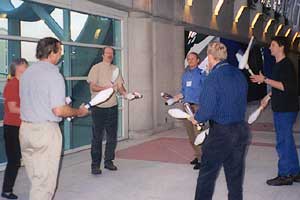

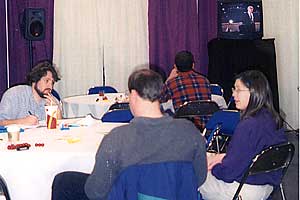
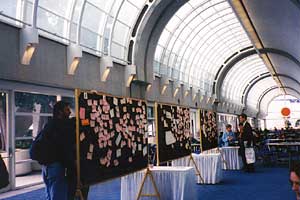
The Email Lab was sponsored by Wolfram Research.
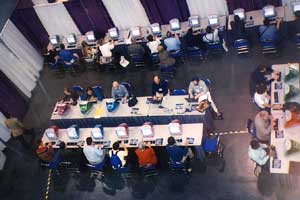
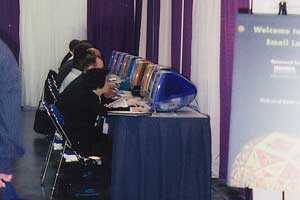
What do HIV and Differential Equations Have in Common?
Sanjay Rai from Jacksonville University answered this question when he spoke about his Mathematical Biology REU (Research Experience for Undergraduates) that he successfully ran in Spring 2001. He mentored six students on several research projects, one of which modeled the effects of various HIV treatments using differential equations. Dr. Rai is one of many professors who are giving undergraduates opportunities to use mathematics in solving real world problems via various REU projects around the country. These efforts have created a whole new group of students that will contribute greatly to the future of the human race. In fact, they are already helping.
--- Mary Ann Saadi, AAAS-AMS Media Fellow, 2000
After agonizing preparation followed by obsessive checking of your messages, you receive an invitation to interview for an academic job. Now what? The MAA-Young Mathematicians Network panel discussion, "Closing the deal: The campus interview and beyond," answers with some academic interview strategies. Before the visit, carefully research the department to determine specific ways your research might fit into the department 's primary interests. Ask for details about your visit--who will you meet? what is your schedule? what sort of talk will you be expected to give? Look at the course schedule to see how many courses and of what level you will teach. Practice your talk! And prepare graceful responses to inappropriate questions (for instance, "I'm sure you'd think me unprofessional were I to answer that"), as well as questions to ask the people you'll be meeting.
Although your talk will be the most important part of the interview, your entire visit will be evaluated, so project confidence and poise throughout. Be honest in your interactions--neither you nor the department will benefit from a hire made under false pretenses."Try on" the job while you visit. Stop talking often enough to listen to people describe their experiences. Don't jump to conclusions about people's opinions--a number theorist may be married to a doctor, so complaining about pre-meds in calculus courses could cost you the job. Phrase your responses positively. Ask promotion-related questions--who decides about tenure? what are requirements for tenure? how many people have retired without tenure? what is the sabbatical policy? how do people spend summers?
Then nail your talk. Be confident and well-spoken. Balance general information with your particular contributions to the field. Point out your accomplishments as you go along. Listen carefully to questions asked at the end--these provide suggestions for improving the talk, leads for future research, and departmental perspective on your work. No matter what, end the talk on time.
After the visit, learn from both successes and failures. Follow up with thank you emails. Think honestly about whether you would be happy in the department, in the school, in the town. If you receive an offer, decline less desirable offers sooner rather than later, but also call schools higher on your list to determine if you should wait for their offer before accepting the one you have.
Good luck!
Kathryn Leonard, AAAS-AMS Media Fellow, 2000
Joint Mathematics Meetings Publicity and the Press Room
The AMS Public Awareness Office generated press releases about the Joint Mathematics Meetingsprior to the Joint Mathematics Meetings which included information about the Press Room, logistics of the annual meetings, selected highlights, invited speakers, prize winners, and the Who Wants To Be A Mathematician contest for local high school students. The Press Room was open for four days and drew staff and freelance science writers, past and current AAAS-AMS Media Fellows, as well as the local newspaper and television media. One San Diego TV station (CBS affiliate KFMB) aired a segment on math education with an interview with Pat Kenschaft (professor at Montclair State University and host of a radio program "Math Medley"), and KFMB and ABC-affiliate KGTV covered the contest and its winner of the grand prize on their evening news programs.
Coverage based on talks at the Joint Mathematics Meetings has appeared to date in: The San Diego Union Tribune (newspaper), New Scientist, Reuters, BBC News, USA Today, The Herald (U.K. newspaper), Business Week, Science and The Chronicle of Higher Education. Please contact the AMS Public Awareness Office via email at paoffice@ams.org for more information.
--- Annette Emerson, AMS Public Awareness Officer
This year 235 AMS members and their spouses and friends came to the AMS Banquet, where J. Ernest Wilkins, Jr. was honored as the longest-term AMS member--61 years!--at the banquet. Hendrik W. Lenstra, Jr. (University of California, Berkeley) gave a talk entitled Pi in de Pieterskerk--the story of how the computation of the number pi was first made public on the tombstone of Dutch mathematician Ludolph van Ceulen [1540-1610] and how it was rediscovered and commemorated in 2000. This social occasion was a wonderful way to end the annual meeting before everyone headed back to their home towns and workplaces.
--- Carol-Ann Blackwood, Manager, AMS Membership
See Highlights of the 2001 Joint Mathematics Meetings in New Orleans.
Photographs by Mike Breen, Annette Emerson, Al Lazzareschi, and Raquel Storti.



